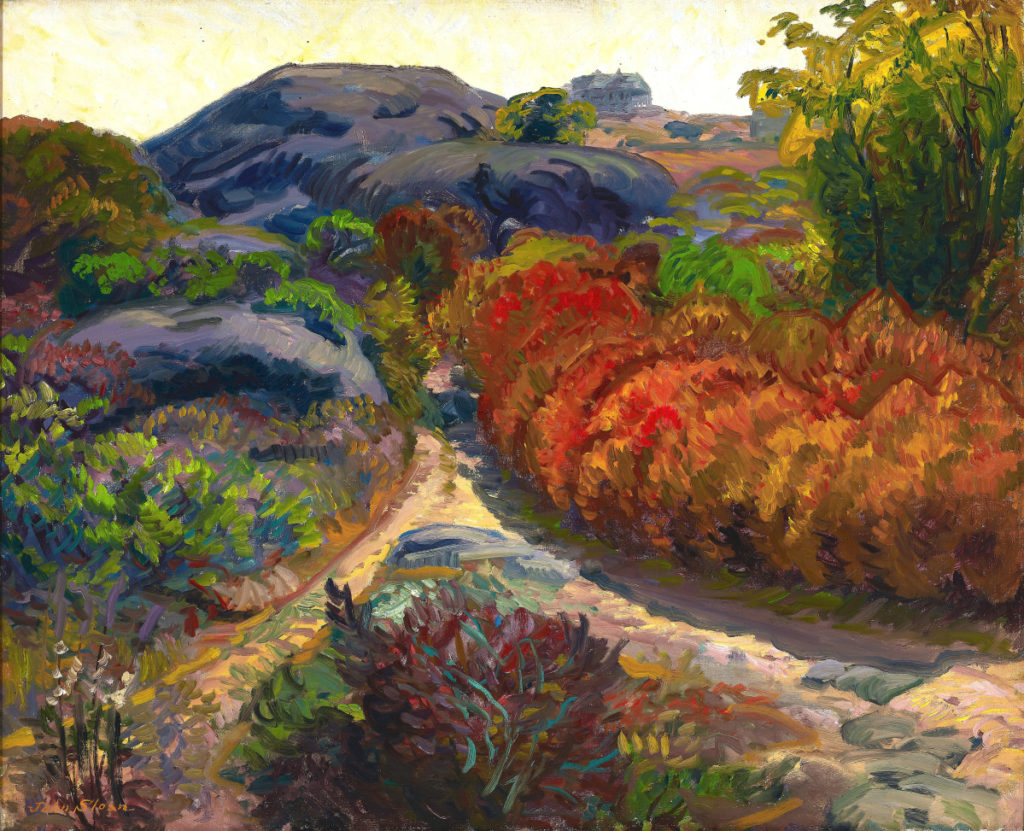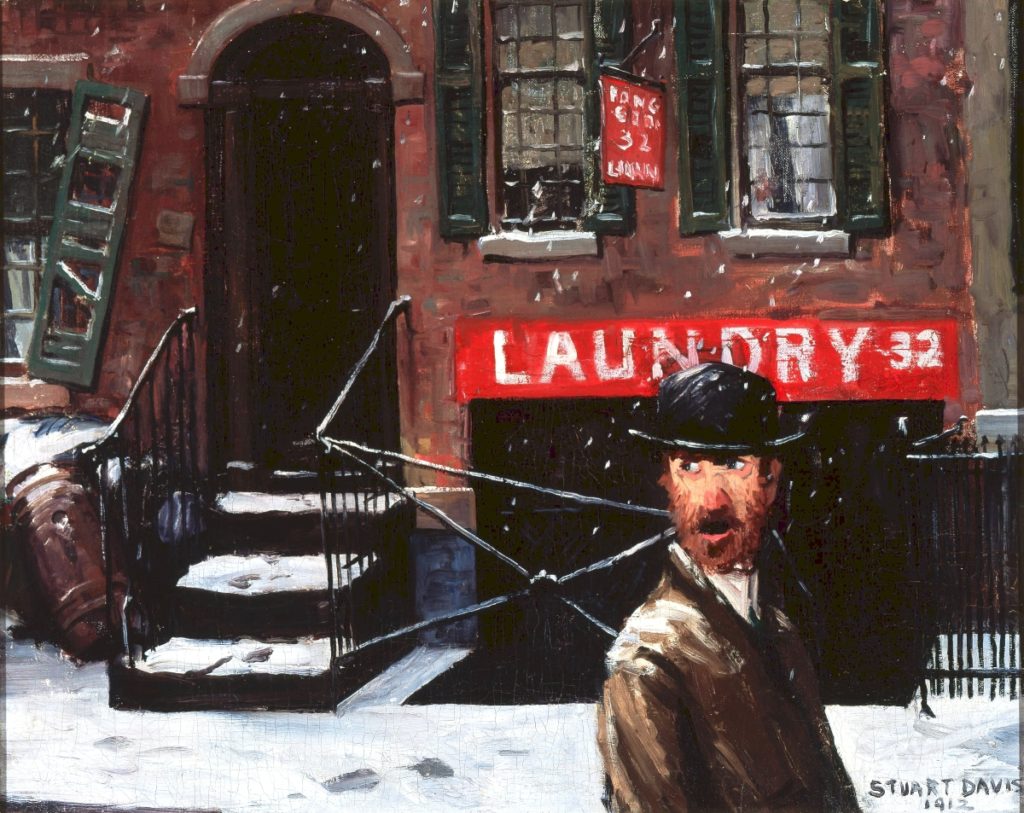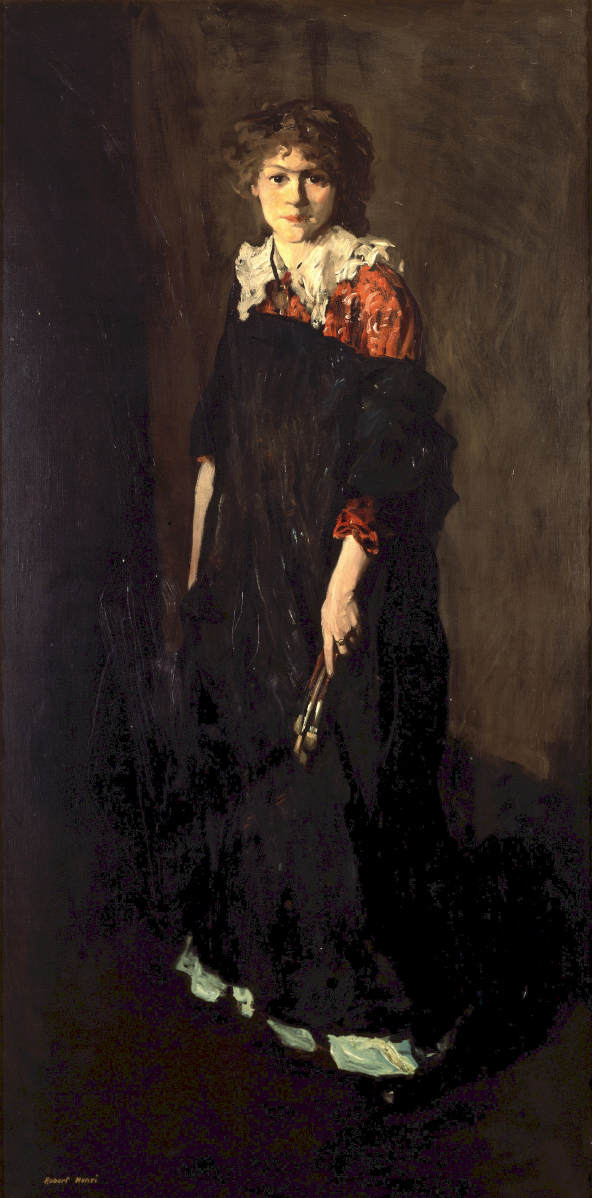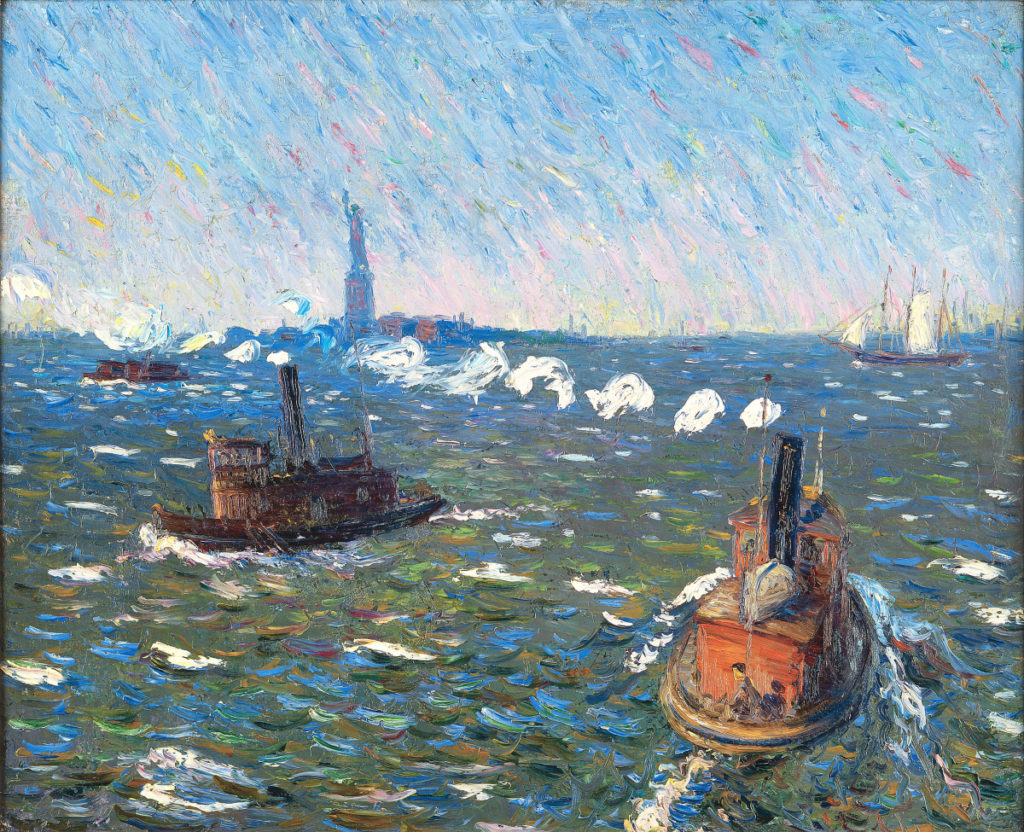
“Autumn Dunes” by John Sloan (1871-1951), 1914, oil on canvas. Gift of Mr and Mrs Donald B. Abert. —John R. Glembin photo
By Jessica Skwire Routhier
MILWAUKEE, WIS. – It has been a long journey for the artists of the so-called Ashcan School, who have gone from the renegades and rebels of American art to the cornerstones of one of the country’s great public collections. These artists, and their work in various media and genres, have been centerpieces of many a blockbuster exhibition since the era of major loan shows began in the 1980s. “The Ashcan School and the Eight: Creating a National Art,” however – while legitimately a blockbuster in terms of its scope, depth of scholarship, and the significance of its related publication – nevertheless harks back to the days when museums’ exhibitions drew more heavily on their own histories and collections. The special relationship between Milwaukee – the Milwaukee Art Museum (MAM) in particular – and the Ashcan School is a central theme of the exhibition, which is on view at MAM through February 19.
The title of the exhibition may initially seem straightforward enough, but in fact it offers much to unpack. First, a definition of terms, beginning with: What’s an ash can? And how exactly does that describe a group of artists? Those who have taken a beginning course in American art history will recall that the term “Ashcan School” describes a group of early Twentieth Century artists who made art that pushed against the stifling academic standards of the National Academy of Design. Some did this simply through technique – looser brushwork and increased abstraction (Arthur Bowen Davies’ “Rhythms”; Maurice Prendergast’s “Picnic by the Sea”) – while others also experimented with subject matter, depicting urban subjects that had previously been considered inappropriate for fine art (George Luks’ “Beecker and Carmine Streets, New York” and “Spoiling for a Fight” by Everett Shinn).
Such urban subjects – along with the darker palette used by Luks and Shinn as well as George Bellows, Robert Henri and Jerome Myers – led a critic from the socialist magazine The Masses to deride their work as “pictures of ashcans and girls hitching up their skirts on Horatio Street.” In this, the writer referred both to an infamous thoroughfare for prostitution in lower Manhattan and to the ubiquity of ash cans, public metal waste receptacles that were meant for the collection of leftover ashes from household fires, to be disposed of elsewhere, but that in practice were used for all kinds of refuse. The assessment was not entirely unfair – Bellows had in fact made a drawing the year before titled “Disappointments of the Ash Can,” published in The Philadelphia Record, which shows three shabbily dressed men weighing the pros and cons of making a meal out of what they found there.

“Tenement Scene” by Stuart Davis (1892-1965), 1912, oil on canvas. Gift of Mrs Harry Lynde Bradley. —John R. Glembin photo
The nickname is no longer a pejorative. In fact, even in the artists’ own historical moment, other critics praised them for their gritty subjects and technique. But the extent to which the artists themselves embraced the “Ashcan School” label is unclear. Years before the term emerged, they had organized under the name “The Eight,” derived from a 1908 exhibition at New York’s Macbeth Galleries that featured artists: Bellows, Davies, Henri, Luks, Myers, Prendergast and Shinn, along with William J. Glackens. The terms “Ashcan School” and “The Eight” have come to be used almost interchangeably to refer to this dynamic and nonconformist group of early Twentieth Century painters and printmakers – even though scholarship has broadened beyond the original eight to include, as in the present exhibition, Ernest Lawson, “Winter Scene”; early work by Stuart Davis, “Tenement Scene;” and Margery Ryerson, the sole female artist in the exhibition.
So much for the first half of the exhibition’s title. What about the second half, referring to a “national art”? Titling an exhibition or a catalog is a tricky business, says Brandon Ruud, the exhibition’s curator. In the end, he explains, the title the curatorial team chose reflects “two parallel strains” of thought about these artists: “On the one hand the critics who were looking at it as this trash art, this rubbish art, inappropriate for the high art of museums…and then on the other hand these critics who are saying no, this is a vibrant new national art…really capturing the United States as it is, in all of its glory and all of its deficits.” Specifically, the phrase comes from critic Mary Fanton Roberts, whose review of the Macbeth show for The Craftsman asked, “The Younger Painters of America: Are They Creating a National Art?”
Roberts was based in New York City, of course, as was The Craftsman and most of the other magazines and critics weighing on The Eight. The artists themselves were also by and large residents, if not natives, of the city, which is a heavy presence in the works on view and in the oeuvre of Ashcan School painters generally. So where does the rest of the United States, and Milwaukee specifically, come into all this?

“The Art Student” by Robert Henri (1865-1929), 1906, oil on canvas. Purchase. —Efraim Lev-er photo
A clue is in Ruud’s title as MAM’s Abert Family curator of American art: the core of MAM’s 150-some works of art from the Ashcan School entered the collection through two generations of the Abert family, beginning with Donald and Barbara Abert. Donald traced his interest in art, and American modernism in particular, to childhood visits to MAM (then the Milwaukee Institute of Art) in the late 1910s and 1920s, when the museum was already specializing in the work of the Ashcan School. As early as 1916, then-director Dudley Crafts Watson organized an exhibition of Henri’s work from the American Southwest, which also caught the eye of board president and collector Samuel O. Buckner. Buckner rapidly acquired more works by Henri and his colleagues, with the museum in mind, and donated his entire collection there in 1919, including Henri’s celebrated “Dutch Joe (Jopie van Slooten).” The Aberts’ donations came in more gradually over time, beginning in the 1960s, but they too collected with the ultimate goal of donating to the museum. Their gifts brought in key works such as Shinn’s “Nightclub Scene” and Sloan’s “Isadora Duncan,” for instance, representing the Ashcan artists’ predilection for the darkened theater. Watson, Buckner and the Aberts thus set an example and paved the way for other important gifts.
The development of MAM’s Ashcan school collection – and the present exhibition – “has really been a community endeavor,” says Ruud, closely tied to the museum’s institutional DNA as well as that of its community. Ruud acknowledges the New York-centrism of much of the artwork but observes that “some of the issues, subjects, and themes that the Ashcan School and the Eight presented…is relevant to any urban or industrializing center,” including Milwaukee. Ruud also points out that travel outside their home base of New York City was an important part of these artists’ practice and development, especially Henri, who was a scholar and teacher as much as a practicing painter (“Tenement Scene” by Stuart Davis, who would eventually become a hard-edge abstractionist, effectively conveys the power of Henri’s influence). The checklist in the catalog includes works by Henri from rural Pennsylvania to California; by Sloan from Cape Ann, Mass., to New Mexico; and by Davies, Lawson and Prendergast that depict idyllic natural settings clearly far outside Manhattan. “So, it really is going back to the idea of the title,” says Ruud. “Location, place and travel really formed and shaped these artists,” particularly travel throughout the United States, giving them a broader approach to an “American” art than the generation that had preceded them.

“Breezy Day, Tugboats, New York Harbor” by William Glackens (1870-1938), circa 1910, oil on canvas. Gift of Mr and Mrs Donald B. Abert and Mrs Barbara Abert Tooman. Photo by John Nienhuis; Dedra Walls.
Still, the idea of a “national art” is a slippery one, in these artists’ time as well as our own, and it is inevitably tied up with politics. This is not a Twenty-First Century overlay; the artists themselves were actively engaged in left-wing causes that they dealt with directly in their art, particularly their prints and drawings. “Their reputation is as being very radical,” says Ruud, noting their break with the National Academy, their daring subject matter, and their contributions to socialist causes and publications. “But what lens are they looking at this through?” he adds. “We visit in the exhibition the idea of what it meant to be radical at that particular time versus what it means to be radical today.”
There is, for instance, no doubting the fervor of Henri’s beliefs. Ruud notes how Henri wrote a piece for The Craftsman on how the communist revolution would be led by artists, “but he was coming at it from a very elevated position, rather than any real understanding perhaps of the nature of labor strife at that particular moment.” The same kind of deeply felt but top-down viewpoint is evident in Henri’s many portraits of unnamed sitters from various ethnic communities, like “Chinese Lady.” The paintings can be baffling to contemporary viewers: are they sensitive and compassionate, or broad and exploitative…or something in between? Henri “made a point of going to different communities and painting portraits,” says Ruud, “but oftentimes did this in a way that did not acknowledge the full identity of the sitter.” Still, Ruud notes, there’s no ignoring the fact that he lavished his paint and the full force of his talents on everyday people, rather than the robber barons who could afford to pay him for it.
The exhibition, according to the museum’s press release, has a stated goal of “draw[ing] connections between the social issues depicted in these works and those still prevalent in the United States today.” It’s all right there in the paintings,” says Ruud, “and also in the texts that accompany them in the gallery space, noting that immigration is a key theme.” “What are we looking at when we see an Ashcan school painter depicting a working community, proletarian community of immigrants?” he asks. “What does that mean 100 years ago? What does it mean today?” By encouraging visitors to ask the questions – of the artists whose work they are viewing as well as themselves – rather than providing pat answers, the exhibition, catalog and attendant education programs offer a framework for thinking about how art, community and history intersect, on both a local scale and a “national” one.
The Milwaukee Art Museum is at 700 North Art Museum Drive. For information, 414-224-3200 or www.mam.org.




















